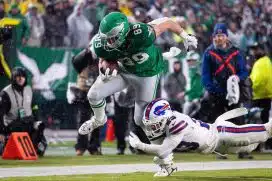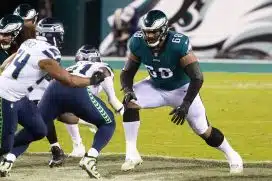By Paul Macrie, Sports Talk Philly staff writer
The Eagles' draft class was received with relatively positive reviews from many writers and reporters connected with the NFL. It appears the team played the board right by drafting defensive end Derek Barnett in the first round and high-upside corner, but injured, Sidney Jones in the second round.
Despite the perceived safe pick in the first round and calculated risk in the second round, did the organization miss the opportunity to take a high-upside feature running back in the second round?
As the Eagles selection was getting closer in the second round, Florida State tailback Dalvin Cook remained available. Before the draft, Cook was regarded as a late first-round, early second-round pick with some off-the-field concerns attached to his name. With the 41st pick, early in the second round, the Minnesota Vikings moved up seven spots to take the high-upside back.
Did the Eagles have an opportunity to move up a few slots to take Cook? There have been rumblings the team indeed had that chance, but opted to hold onto their first choice in the fourth round at 118th overall. If that was the case, the team might have made a mistake, especially since they had another fourth round pick at their disposal, courtesy of the pre-draft trade with the Cleveland Browns last year.
The Eagles 118th overall selection ended up being Mack Hollins, wide receiver from North Carolina, and by staying at No. 43 overall, they chose Jones, the well-regarded but injured corner from Washington. This particular part of the draft could essentially make-or-break the overall outcome of the 2017 class, especially when looking back at it in a couple of years.
If Jones turns out to be the shutdown press coverage corner many experts believe he can be, then it will be an afterthought that the Eagles elected not to move up a few spots to take Cook. It remains to be seen if Cook will even be the star at the NFL level that he was at Florida State. He is undersized, and didn't produce positive combine results, but that doesn't always equate to similar outcomes on the football field with actual pads on. There have been plenty of undersized tailbacks that have succeeded in the league.
Going back to Jones, he is currently rehabbing an Achilles injury sustained during his pro day in March. It is believed the injury will require at least six months to recover from, but it could take even longer than that. He is aiming to return sometime in October, but the team hasn't ruled out shutting him down for the entire season, essentially making this a redshirt season.
This isn't new territory for a Philadelphia team, as in recent years the Sixers have done this with Nerlens Noel, Joel Embiid — who missed two full seasons — and Ben Simmons.
The Eagles did take a running back in the draft, trading up seven spots in the fourth round from 139 to 132 to take Donnel Pumphrey from San Diego State. Pumphrey had an illustrious collegiate career, rushing for more than 5,000 yards in his career, but he is only listed at 5'8" and 176 pounds. He has been compared to current Eagle Darren Sproles and Charger Dexter McCluster, among smaller backs that have had success in the NFL. He is a potential dynamic playmaker that could replace Sproles, who is set to retire after the 2017 season. But he isn't likely to be the workhorse tailback that a player such as Cook could be.
As of now, the Eagles running back depth chart look like this: Ryan Mathews – coming back from a major back/neck injury and possibly expected to be cut to save the team cap space — Wendell Smallwood – entering his second season — Sproles and Pumphrey.
For those that say the running back position has been devalued, it depends on the interpretation of that. Yes, it is a passing league more than ever, but an efficient backfield helps open up the passing game, too. One-dimensional teams struggle no matter the league. The New England Patriots didn't win because of LeGarrette Blount last season, but it sure helped that he was a red zone star with a league-high 18 rushing touchdowns.
It doesn't have to be a big-name back, but the current crop of Eagles running backs don't have major upside in helping a team that has struggled for several seasons in short-yardage situations. Could Cook have been that answer if the team elected to move up a few positions to grab him? He has better upside than Pumphrey, though head coach Doug Pederson appears to prefer the do-it-all type backs such as Pumphrey.
Did the Eagles miss the opportunity to draft a top-flight running back? The true answer won't come for at least a year, if not more. It all hinges on Sidney Jones' recovery from a major injury, and Donnel Pumphrey's long-term development.







